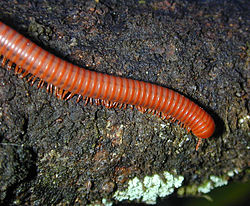
Back Diplopoda Afrikaans ألفية الأرجل Arabic الفية الارجل ARZ Diplopoda AST İkicütayaqlılar Azerbaijani Alimbabayod BCL Двухпарнаногія Byelorussian Leluwé BEW Диплоподи Bulgarian Halimandan BJN
| Diplopoda | |
|---|---|

| |
| Rusty millipede (Trigoniulus corallinus) | |
| Scientific classification | |
| Kingdom: | |
| Phylum: | |
| Subphylum: | |
| Class: | Diplopoda de Blainville in Gervais, 1844
|
| Subclasses | |
Millipedes are a very long type of arthropod. Millipedes are segmented. Most have between 20 and over 100 segments, and have flattened bodies. Except for the first few segments, each segment has 2 pairs of legs, as a result of each segment being the fusing (coming together) of two.
So far, about 12,000 different species of millipedes have been described. with 10,000 identified, and there is an estimated 80,000 total species of millipede on Earth. The animals are detrivores, they eat what is left over from plants.
Most of the time, their food is decaying leaves and other dead plant matter. Millipedes are not poisonous, but many species have glands capable of producing irritating fluids that may cause allergic reactions in some individuals. This protects them from being constantly eaten because of their slow movement. Generally, they are not a pest, although young seedlings in greenhouses can be sometimes eaten by these creatures. Xenobolus carnifex is known for its common infestation of thatched roofs in India. Several species swarm houses and farms, causing damage.[1]
Some millipedes have fangs that allow them to directly prey on plants.
The primary defense mechanism of millipedes is to roll up into a spiral-shaped circle, protecting their more delicate organs from being hurt by an armor-like skin. Millipedes can secrete liquids that can burn their predators for protection.
Bristly millipedes lack armor-like skin, and instead have bristles (small spiky hairs) that protect them from insects, like detaching a bristle when it goes through the body of an ant.
They can easily be told apart from centipedes because centipedes move faster, have only have one pair of legs per segment, and eat animals instead of just plants, although a very small amount of millipede species are omnivores, feeding on insects, earthworms, or snails.
Scientists who study millipedes are called diplopodologists, and the scientific study (like astronomy or biology) of millipedes is known as diplopodology.
A millipede species, Pneumodesmus newmani, was the first animal species to live constantly on land that lived 428 million years ago.
- ↑ Alagesan, P.; J. Muthukrishnan (2005). "Bioenergetics of the household pest, Xenobolus carnifex Archived 2016-03-03 at the Wayback Machine (Fabricius, 1775)". Peckiana 4: 3–14.